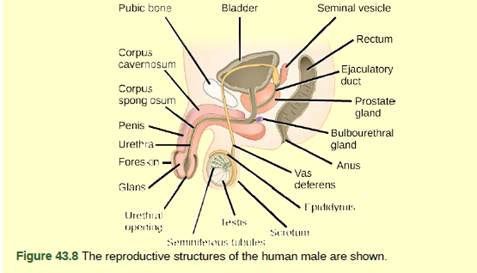
Figure 43.8 Which of the following statements about the male reproductive system is false?
- The vas deferens carries sperm from the testes to the penis.

Introduction:
The male reproductive system comprises a number of sex organs, which plays a function in the procedure of human reproduction. The male organs are present exterior to the body indside the pelvis. The main sex organs are the testicles and the penis, which generate sperm and semen, that is, as a part of sexual intercourse, fertilize an ovum in the body of a female.
Answer to Problem 1VCQ
Correct answer:
The correct answer is option (d) the prostate gland is located in the testes.
Explanation of Solution
Explanation/justification for the correct answer:
Option (d) the prostate gland is located in the testes. The prostate gland is not located inside the testes. It is one of the male accessory glands that are situated between the penis and the urinary bladder. This gland generated fluid that nourishes as well as safeguards semen. So, the correct answer is option (d).
Explanation for the incorrect answer:
Option (a) the vas deferens carries sperm from the testes to the penis. The sperms are generated in the male gonads, that is, the testes. From the site of generation, they are conducted through the vas deferens towards the seminal vesicles that supplements its own discharging to the oncoming sperms. Then the semen is transmitted towards the penis via an ejaculatory duct that unites with the urinary duct to produce a common duct. So, this is an incorrect option.
Option (b) sperm mature in seminiferous tubules in the testes. The maturation of sperm takes place in the seminiferous tubules. These tubules are situated in the testes. So, this is an incorrect option.
Option (c) both the prostate and bulbourethral glands produce components of the semen. The prostate gland generates a milky fluid that produces the semen with viscosity. While the bulbourethral gland supplements a neutralizing fluid in the semen. So, this is an incorrect option.
The statement, that is, the prostate gland is situated in the testes is false. Hence, the false statement is option (d) the prostate gland is located in the testes.
Want to see more full solutions like this?
Chapter 43 Solutions
Biology 2e
Additional Science Textbook Solutions
College Physics: A Strategic Approach (3rd Edition)
Genetic Analysis: An Integrated Approach (3rd Edition)
Applications and Investigations in Earth Science (9th Edition)
Biology: Life on Earth (11th Edition)
Microbiology: An Introduction
Human Anatomy & Physiology (2nd Edition)
- Molecular Biology Explain why changing the codon GGG to GGA should not be harmful. Please help . Thank youarrow_forwardStage Percent Time in Hours Interphase .60 14.4 Prophase .20 4.8 Metaphase .10 2.4 Anaphase .06 1.44 Telophase .03 .72 Cytukinesis .01 .24 Can you summarize the results in the chart and explain which phases are faster and why the slower ones are slow?arrow_forwardCan you circle a cell in the different stages of mitosis? 1.prophase 2.metaphase 3.anaphase 4.telophase 5.cytokinesisarrow_forward
- Which microbe does not live part of its lifecycle outside humans? A. Toxoplasma gondii B. Cytomegalovirus C. Francisella tularensis D. Plasmodium falciparum explain your answer thoroughly.arrow_forwardSelect all of the following that the ablation (knockout) or ectopoic expression (gain of function) of Hox can contribute to. Another set of wings in the fruit fly, duplication of fingernails, ectopic ears in mice, excess feathers in duck/quail chimeras, and homeosis of segment 2 to jaw in Hox2a mutantsarrow_forwardSelect all of the following that changes in the MC1R gene can lead to: Changes in spots/stripes in lizards, changes in coat coloration in mice, ectopic ear formation in Siberian hamsters, and red hair in humansarrow_forward
- Pleiotropic genes are genes that (blank) Cause a swapping of organs/structures, are the result of duplicated sets of chromosomes, never produce protein products, and have more than one purpose/functionarrow_forwardA loss of function mutation in Pitx1 enhancers can cause (blank) Removal of Pitx1 exons and growth of ectopic hindlimbs, growth of extra ectopic forelimbs, loss of forelimb specification and development, and loss of hindlimb specification and developmentarrow_forwardHox1a most likely contributes to (blank) patterning in the developing embryo? Ventral, posterior, limb or anteriorarrow_forward
- Select all of the following that can help establish Hox gene expression boundaries (things that affect Hox and not things that Hox affects). Retinoic acid, anterior/posterior axis, fibroblast growth factors, vagal neural crest, and enhancersarrow_forwardEctopic expression of Hox often results in (blank) phenotypes. (Blank) transformations are characterized by the replacement of one body part/structure with another. Hoxeotic, homealoneotic, joexotic, or homeoticarrow_forwardWhat's the difference when drawing omega-6 and omega-3?arrow_forward
 Biology 2eBiologyISBN:9781947172517Author:Matthew Douglas, Jung Choi, Mary Ann ClarkPublisher:OpenStax
Biology 2eBiologyISBN:9781947172517Author:Matthew Douglas, Jung Choi, Mary Ann ClarkPublisher:OpenStax Concepts of BiologyBiologyISBN:9781938168116Author:Samantha Fowler, Rebecca Roush, James WisePublisher:OpenStax College
Concepts of BiologyBiologyISBN:9781938168116Author:Samantha Fowler, Rebecca Roush, James WisePublisher:OpenStax College Human Biology (MindTap Course List)BiologyISBN:9781305112100Author:Cecie Starr, Beverly McMillanPublisher:Cengage Learning
Human Biology (MindTap Course List)BiologyISBN:9781305112100Author:Cecie Starr, Beverly McMillanPublisher:Cengage Learning Human Physiology: From Cells to Systems (MindTap ...BiologyISBN:9781285866932Author:Lauralee SherwoodPublisher:Cengage Learning
Human Physiology: From Cells to Systems (MindTap ...BiologyISBN:9781285866932Author:Lauralee SherwoodPublisher:Cengage Learning





